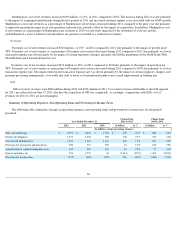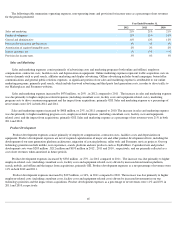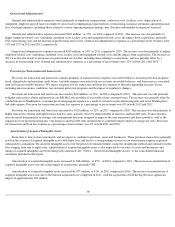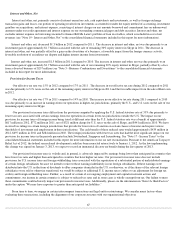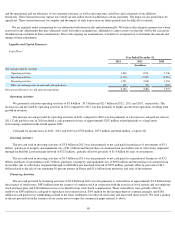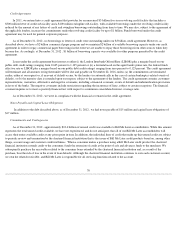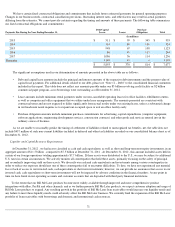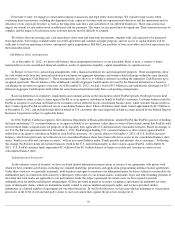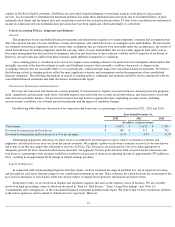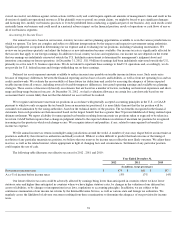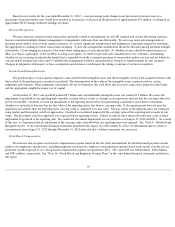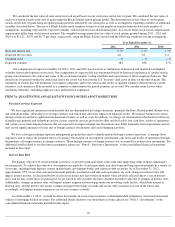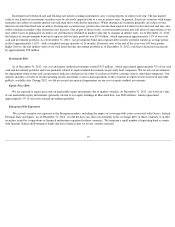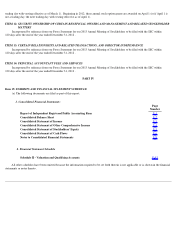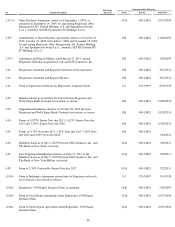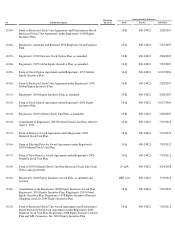eBay 2012 Annual Report Download - page 78
Download and view the complete annual report
Please find page 78 of the 2012 eBay annual report below. You can navigate through the pages in the report by either clicking on the pages listed below, or by using the keyword search tool below to find specific information within the annual report.
even if successful, our defense against certain actions will be costly and could require significant amounts of management's time and result in the
diversion of significant operational resources. If the plaintiffs were to prevail on certain claims, we might be forced to pay significant damages
and licensing fees, modify our business practices or even be prohibited from conducting a significant part of our business. Any such results could
materially harm our business and could result in a material adverse impact on the financial position, results of operations or cash flows of any or
all of our business segments.
Accounting for Income Taxes
Our annual tax rate is based on our income, statutory tax rates and tax planning opportunities available to us in the various jurisdictions in
which we operate. Tax laws are complex and subject to different interpretations by the taxpayer and respective government taxing authorities.
Significant judgment is required in determining our tax expense and in evaluating our tax positions, including evaluating uncertainties. We
review our tax positions quarterly and adjust the balances as new information becomes available. Our income tax rate is significantly affected by
the tax rates that apply to our foreign earnings. In addition to local country tax laws and regulations, our income tax rate depends on the extent
that our earnings are indefinitely reinvested outside the U.S. Indefinite reinvestment is determined by management's judgment about and
intentions concerning our future operations. At December 31, 2012 , $11.9 billion of earnings had been indefinitely reinvested outside the U.S.,
primarily in active non-U.S. business operations. We do not intend to repatriate these earnings to fund U.S. operations and, accordingly, we do
not provide for U.S. federal income and foreign withholding tax on these earnings.
Deferred tax assets represent amounts available to reduce income taxes payable on taxable income in future years. Such assets arise
because of temporary differences between the financial reporting and tax bases of assets and liabilities, as well as from net operating loss and tax
credit carryforwards. We evaluate the recoverability of these future tax deductions and credits by assessing the adequacy of future expected
taxable income from all sources, including reversal of taxable temporary differences, forecasted operating earnings and available tax planning
strategies. These sources of income rely heavily on estimates that are based on a number of factors, including our historical experience and short-
range and long-range business forecasts. At December 31, 2012 , we had a valuation allowance on certain loss carryforwards based on our
assessment that it is more likely than not that the deferred tax asset will not be realized.
We recognize and measure uncertain tax positions in accordance with generally accepted accounting principles in the U.S., or GAAP,
pursuant to which we only recognize the tax benefit from an uncertain tax position if it is more likely than not that the tax position will be
sustained on examination by the taxing authorities, based on the technical merits of the position. The tax benefits recognized in the financial
statements from such positions are then measured based on the largest benefit that has a greater than 50 percent likelihood of being realized upon
ultimate settlement. We report a liability for unrecognized tax benefits resulting from uncertain tax positions taken or expected to be taken in a
tax return. GAAP further requires that a change in judgment related to the expected ultimate resolution of uncertain tax positions be recognized
in earnings in the quarter in which such change occurs. We recognize interest and penalties, if any, related to unrecognized tax benefits in
income tax expense.
We file annual income tax returns in multiple taxing jurisdictions around the world. A number of years may elapse before an uncertain tax
position is audited by the relevant tax authorities and finally resolved. While it is often difficult to predict the final outcome or the timing of
resolution of any particular uncertain tax position, we believe that our reserves for income taxes reflect the most likely outcome. We adjust these
reserves, as well as the related interest, where appropriate in light of changing facts and circumstances. Settlement of any particular position
could require the use of cash.
The following table illustrates our effective tax rates for 2012 , 2011 and 2010 :
Our future effective tax rates could be adversely affected by earnings being lower than anticipated in countries where we have lower
statutory rates and higher than anticipated in countries where we have higher statutory rates, by changes in the valuation of our deferred tax
assets or liabilities, or by changes or interpretations in tax laws, regulations or accounting principles. In addition, we are subject to the
continuous examination of our income tax returns by the Internal Revenue Service, as well as various state and foreign tax authorities. We
regularly assess the likelihood of adverse outcomes resulting from these examinations to determine the adequacy of our provision for income
taxes.
74
Year Ended December 31,
2012
2011
2010
(In millions, except percentages)
Provision for income taxes
$
475
$
681
$
297
As a % of income before income taxes
15
%
17
%
14
%


